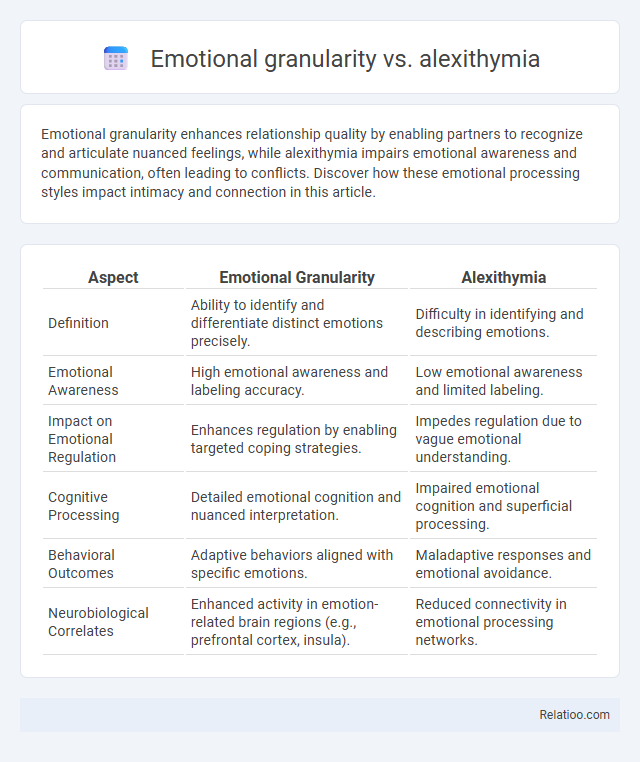Emotional granularity enhances relationship quality by enabling partners to recognize and articulate nuanced feelings, while alexithymia impairs emotional awareness and communication, often leading to conflicts. Discover how these emotional processing styles impact intimacy and connection in this article.
Table of Comparison
| Aspect | Emotional Granularity | Alexithymia |
|---|---|---|
| Definition | Ability to identify and differentiate distinct emotions precisely. | Difficulty in identifying and describing emotions. |
| Emotional Awareness | High emotional awareness and labeling accuracy. | Low emotional awareness and limited labeling. |
| Impact on Emotional Regulation | Enhances regulation by enabling targeted coping strategies. | Impedes regulation due to vague emotional understanding. |
| Cognitive Processing | Detailed emotional cognition and nuanced interpretation. | Impaired emotional cognition and superficial processing. |
| Behavioral Outcomes | Adaptive behaviors aligned with specific emotions. | Maladaptive responses and emotional avoidance. |
| Neurobiological Correlates | Enhanced activity in emotion-related brain regions (e.g., prefrontal cortex, insula). | Reduced connectivity in emotional processing networks. |
Understanding Emotional Granularity
Emotional granularity refers to the ability to identify and differentiate between specific emotions with precision, fostering better emotional regulation and mental health. Alexithymia, characterized by difficulty in recognizing and describing emotions, represents a deficit in emotional granularity and is linked to various psychological disorders. Enhancing emotional granularity through mindfulness and emotional awareness training improves emotional intelligence and resilience.
What is Alexithymia?
Alexithymia is a psychological condition characterized by difficulty in identifying, describing, and expressing emotions, often leading to a limited emotional awareness and impaired emotional granularity. Unlike emotional granularity, which involves the ability to distinctly label and differentiate subtle emotional experiences, alexithymia results in a more generalized and vague emotional state. This condition affects social functioning and emotional regulation, contributing to challenges in interpersonal relationships and mental health.
Key Differences: Emotional Granularity vs Alexithymia
Emotional granularity refers to the ability to identify and distinguish between nuanced emotional experiences, enhancing emotional awareness and regulation. Alexithymia, in contrast, is characterized by difficulty in recognizing, describing, and processing emotions, often leading to emotional confusion and impaired social functioning. The key difference lies in emotional granularity's facilitation of detailed emotional understanding versus alexithymia's marked deficit in emotional clarity and expression.
Psychological Roots of Emotional Granularity
Emotional granularity refers to the ability to identify and differentiate between discrete emotions, rooted in psychological processes involving emotional awareness and cognitive labeling. Alexithymia, by contrast, is characterized by difficulty in recognizing and describing emotions, reflecting impairments in emotional processing and interoceptive awareness. Your capacity for emotional granularity depends on neural mechanisms in the anterior cingulate cortex and prefrontal regions that facilitate nuanced emotional representation and regulation.
Causes and Symptoms of Alexithymia
Alexithymia arises from a combination of genetic predispositions, early childhood trauma, and neurodevelopmental factors affecting emotional processing. Symptoms include difficulty identifying and describing one's own emotions, limited imagination, and a tendency toward externally oriented thinking. In contrast, emotional granularity refers to the ability to precisely differentiate and label emotions, promoting greater emotional awareness and regulation.
Emotional Vocabulary and Self-Awareness
Emotional granularity refers to the ability to precisely identify and label your emotions using a rich emotional vocabulary, which enhances self-awareness and emotional regulation. Alexithymia is characterized by difficulties in recognizing and describing emotions, leading to a limited emotional vocabulary and impaired self-awareness. Developing emotional granularity improves your capacity to understand and express complex emotions clearly, fostering better emotional health and interpersonal relationships.
Impact on Mental Health and Relationships
Emotional granularity, the ability to precisely identify and differentiate your emotions, enhances mental health by promoting effective emotional regulation and reducing stress-related symptoms. In contrast, alexithymia, characterized by difficulty in recognizing and expressing emotions, often leads to increased anxiety, depression, and impaired interpersonal relationships due to emotional miscommunication. Developing emotional granularity improves your emotional intelligence, fostering healthier relationships and greater psychological resilience.
Assessment Tools and Diagnostic Criteria
Emotional granularity refers to the ability to distinguish and label specific emotions, assessed using tools like the Levels of Emotional Awareness Scale (LEAS) and the Emotion Differentiation Task, which measure nuanced emotional awareness. Alexithymia, characterized by difficulties in identifying and describing emotions, is typically diagnosed using the Toronto Alexithymia Scale (TAS-20) and the Bermond-Vorst Alexithymia Questionnaire (BVAQ), focusing on deficits in emotional processing. Understanding your emotional granularity can guide the choice of these assessment tools and clarify diagnostic criteria, aiding in tailored therapeutic interventions.
Strategies to Enhance Emotional Granularity
Emotional granularity refers to the ability to precisely identify and differentiate between your emotions, which contrasts with alexithymia, a condition marked by difficulty recognizing and describing feelings. Strategies to enhance emotional granularity include practicing mindfulness meditation to increase present-moment awareness, journaling about specific emotional experiences, and expanding emotional vocabulary through reading and therapy. These techniques help you gain better emotional insight, improving emotional regulation and mental well-being.
Therapeutic Approaches for Alexithymia
Therapeutic approaches for alexithymia primarily focus on enhancing emotional granularity, which is the ability to identify and differentiate between nuanced emotional states. Techniques such as cognitive-behavioral therapy (CBT), mindfulness practices, and emotion-focused therapy (EFT) help individuals improve emotional awareness and expressivity, reducing the alexithymic difficulty in recognizing and describing feelings. Developing emotional granularity through these treatments has shown efficacy in addressing the core deficits of alexithymia and improving overall emotional regulation and mental health outcomes.

Infographic: Emotional granularity vs Alexithymia
 relatioo.com
relatioo.com